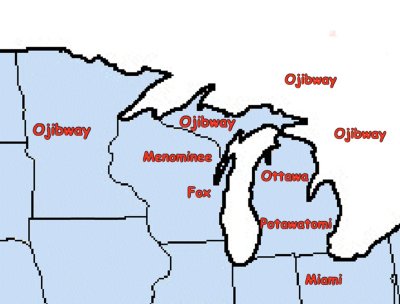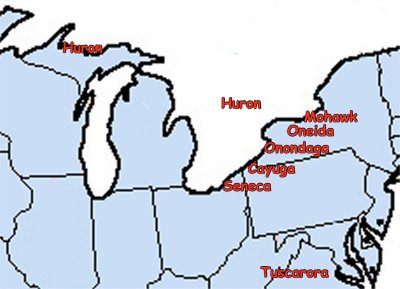Indian Languages
It doesn't look good for Chogan and Kanti. They are under attack by fierce warriors who dress and look unlike any people Chogan has ever seen before. And they are speaking a language Chogan cannot understand. If you think all Indians speak “Indian” this may come as a surprise. Actually, Indians speak over two hundred different languages. Many of these languages are similar, and individuals speaking one of these similar languages can often communicate, although with some difficulty.
Chogan speaks the Ojibway language, which belongs to the Algonquian language group. This is one of the largest Indian language groups in North America. People to the east of Chogan’s people speak languages that belong to the Iroquoian group, while Indians to the west speak one of the Siouan languages.
Sadly, it is human nature that people who have different languages, customs, skin color, or beliefs do not always play well together. As you can see from the maps below, there is considerable overlap of tribes belonging to the various language groups. This frequently caused conflicts and sometimes entire tribes were forced from their homeland.
Algonquian Languages

Chogan belonged to a very large tribe that spread across northern Minnesota, Wisconsin, Michigan, and into Canada. The Ojibway language was different, but still similar to other Algonquian language speakers like the Menominee, Fox, Miami, Ottawa, and Potawatomi. The Ojibway, Ottawa, and Potawatomi had linguistically similar languages, and together they formed a social and political alliance called the Three Fires. Using birch bark scrolls, a Potawatomi elder dated the formation of the Council of Three Fires to 796 AD at Michilimackinac, which is located at the northern tip of Lower Michigan. Their united front created a formidable foe to the Siouan Nations to the west and the Iroquoian Nations to the east.
Siouan Languages

Normally when we think of Sioux we are referring to the Dakota Indians. At one time they occupied Michigan’s Upper Peninsula and Wisconsin, but the Ojibway Indians drove them west into the western plains. In Chogan’s time the Sioux territories and Ojibway territories overlapped. The two nations fought numerous battles over the wild rice fields of Wisconsin and Minnesota. The Winnebago are one of the few Siouan language tribes still remaining in Wisconsin. For the most part, the Winnebago and Ojibway Indians lived in peace. You will read more about the Winnebago later in the novel.
Iroquoian Languages

We haven’t mentioned much about the fierce Iroquoian Indians to the east, but this may change in future Chogan novels. The most notable nations belonged to the Iroquois Confederacy, which consisted of the Mohawk, Oneida, Onondaga, Cayuga, and the Seneca. They were called the Five Nations until 1722 when the Tuscarora Indians joined the Confederacy making it the Six Nations. According to oral tradition, the Ojibway people once lived along the Atlantic coast, but the Iroquois forced them west toward the Great Lakes. The Huron Indians spoke an Iroquoian language, but were not part of the Iroquois Confederacy. They were almost exterminated by the much larger Iroquois Confederacy. A few Huron Indians fled to Michigan’s Upper Peninsula, where the Ojibway allowed them to settle northwest of present-day Marquette in what is now called the Huron Mountains. But that's enough about other Indians; let’s get back to Chogan and Kanti and see if they survive the attack by the Sioux warriors.
